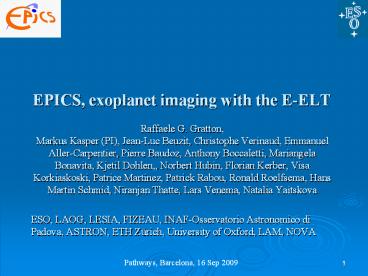EPICS, exoplanet imaging with the E-ELT - PowerPoint PPT Presentation
1 / 24
Title:
EPICS, exoplanet imaging with the E-ELT
Description:
Markus Kasper (PI), Jean-Luc Beuzit, Christophe Verinaud, Emmanuel Aller ... Roelfsema, Hans Martin Schmid, Niranjan Thatte, Lars Venema, Natalia Yaitskova ... – PowerPoint PPT presentation
Number of Views:158
Avg rating:3.0/5.0
Title: EPICS, exoplanet imaging with the E-ELT
1
EPICS, exoplanet imaging with the E-ELT
- Raffaele G. Gratton,Markus Kasper (PI), Jean-Luc
Beuzit, Christophe Verinaud, Emmanuel
Aller-Carpentier, Pierre Baudoz, Anthony
Boccaletti, Mariangela Bonavita, Kjetil Dohlen,,
Norbert Hubin, Florian Kerber, Visa Korkiaskoski,
Patrice Martinez, Patrick Rabou, Ronald
Roelfsema, Hans Martin Schmid, Niranjan Thatte,
Lars Venema, Natalia Yaitskova - ESO, LAOG, LESIA, FIZEAU, INAF-Osservatorio
Astronomico di Padova, ASTRON, ETH Zürich,
University of Oxford, LAM, NOVA
1
2
Outline
- Science goals
- Instrument and AO concept
- Science Output prediction
3
Exoplanets observations 2009
- Close to 400 Exoplanets detected, gt80 by radial
velocities, mostly gas giants, a dozen Neptunes
and a handful of Super-Earths
- Constraints on Mass function, orbit distribution,
metallicity - Some spectral information from transiting planets
3
4
(Some) open issues
- Planet formation (core accretion vs gravitational
disk instability) - Planet evolution (accretion shock vs spherical
contraction / hot start) - Orbit architecture (Where do planets form?, role
of migration and scattering) - Abundance of low-mass and rocky planets
- Giant planet atmospheres
4
5
Object Class 1, young self-lumPlanet formation
5
6
Object Class 2, within 20 pcOrbit architecture,
low-mass planet abundance
500 stars from Paranal 30 deg, 60-70
M-dwarfs
- Requirements
- High contrasts10-9 at 250 mas (Jupiter at
20pc) - spatial resolution 10-8 at 40 mas (Gl
581d,8 M?)
6
7
Object Class 3, already known onesPlanet
evolution and atmospheres
- discovered by RV, 8-m direct imaging (SPHERE,
GPI) or astrometric methods (GAIA, PRIMA)
7
8
Contrast requirements summary
9
Concept
9
10
Concept Achieve very high contrast
- Highest contrast observations require multiple
correction stages to correct for - Atmospheric turbulence
- Diffraction Pattern
- Quasi-static instrumental aberrations
NIR diffraction suppression
x 1000 !
11
XAO concept
- Main parameters (baseline)
- Serial SCAO, M4 / internal WFS, XAO
- XAO roof PWS at 825 nm, 3 kHz
- 200x200 actuators (20 cm pupil spacing)
Advanced RTC algorithms studied in parallel to
EPICS phase-A
Simulation by Visa Korkiakoski
11
AO coro
12
High Order Testbench (HOT)Demonstrate XAO / high
contrast concepts
- Developed at ESO in collaboration with Arcetri
and Durham Univ. - Turb. simulator, 32x32 DM, SHS, PWS,
coronagraphy, NIR camera - H-band Strehl ratios 90 in 0.5? seeing (SPIE
2008, Esposito et al. Aller-Carpentier et al. )
correcting 8-m aperture for 600 modes
Aller-Carpentier, proc. AO4ELT
13
HOT XAO with APL coronagraph
Martinez et al., submitted to AAL
- Good agreement with SPHERE simulations
- Additional gain by quasi-static speckle
calibration (SDI, ADI)
14
Residual PSF calibration
- From systematic PSF residuals (10-6-10-7) to
10-8-10-9 - Spectral Deconvolution (SparksFord, Thatte et
al.), Trade-off spectral bandwidth vs inner
working angle,? IFS (baseline Y-H) - Polarimetric differential imaging for smallest
separation, needs planet feature (e.g. CH4
band, or polarization)? EPOL (600-900 nm) - Coherence based methods (speckles interfere with
Airy Pattern, a planet does not) ? Self-Coherent
camera (Baudoz et al, Proc. AO4ELT) - Angular Differential Imaging (ADI) ? All
15
Example Spectral Deconvolution
15
16
Speckle chromaticity and Fresnel
SD needs smooth speckle spectrum -gt near-pupil
optics
20 nm rms at 10x Talbot
20 nm rms in pupil plane
17
End-2-end analysis
- Apodizer only leads to improved final contrast
APLC
18
Baseline Concept
All optics near the pupil planeminimize
amplitude errors and speckle irregular
chromaticity
19
Detection limits, incl. photon noise
20
Detection rates, MC simulation
20
21
Predicted Science Output
- MC simulations
- planet population with orbit and mass
distribution from Mordasini et al. (2009) - Model planet brightness (thermal, reflected,
albedo, phase angle,) - Match statistics with RV results
- Contrast model
- Analytical AO model incl. realistic error budget
- Spectral deconvolution
- No diffraction or static WFE
- Y-H, 10 throughput, 4h obs
22
Detection rates, nearbyyoung stars
Contrast requirements
Simulations by M. Bonavita
23
Predicted EPICS output
Target class targets Self-luminous planets Giant planets Neptunes Rocky planets
1. Young stars 688 100 (100) Dozens Very few (?)
2. Nearby stars 512 Dozen 100 Dozens Dozen
3. Stars w. planets gt100 Some gt100 gtDozen gt2
23
24
Summary
- EPICS is the NIR E-ELT instrument for Exoplanet
research - Phase-A to study concept, demonstrate feasibility
by prototyping, provide feedback to E-ELT and
come up with a development plan - Conclusion of Phase-A early 2010
- Exploits E-ELT capabilities (spatial resolution
and collecting power) in order to greatly advance
Exoplanet research (discovery and
characterization)































